Do Safety Features On Cars Reduce The Odds Of A Crash
Advances in automotive technology have made our cars faster, more fuel-efficient, more comfortable, and more convenient than ever before. Technological additions also include safety features that many motorists wouldn’t have thought possible years ago. Gone are the days where the idea of a new safety feature was a side-impact airbag; today’s vehicles have rear-mounted cameras, collision detection, blind-spot sensors, lane departure warnings, and more. Do these features actually reduce the odds of being in an accident, though?
Some Technology Is Life Saving
Not all safety technology is proven to be effective for reasons that will be discussed momentarily. There is at least one piece of equipment that has been shown to be life-saving, to the point where the Department of Transportation has made it a mandatory feature on all new automobiles as of May 2018; rearview video systems. This technology allows drivers to more easily see the area directly behind their vehicle, something incredibly helpful when it comes to avoiding backing up into smaller objects, bicyclists, people, and children. As noted by the National Highway Traffic Safety Administration, though, this technology should not be a substitute for using a vehicle’s mirrors and the driver physically turning around to look behind themselves. Not exercising proper safety protocol is an example of negligence, and could cause an accident that potentially leaves you liable to a lawsuit. Over-reliance on technology is another problem all to itself.
Drivers Need To Understand Safety Features
People aren’t perfect and neither is technology. Blind-spot monitoring systems, for example, aren’t always accurate, since they can’t reliably detect vehicles that are traveling at high rates of speed. This might sound like something a driver could anticipate or adjust to, except for the fact that not all drivers are aware of this fact. Nearly 80% of drivers that were surveyed regarding this technology were unaware of its limitations. Furthermore, additional studies revealed that up to 40% of drivers weren’t familiar with how forward-collision warning and automatic braking systems functioned, with some of that group confusing the two with each other. This is one of many factors that make it difficult to assess if these features are truly helping, considering the number of fatal accidents has remained at roughly 40,000 per year in 2016, 2017, and 2018.
Safety Features Can Still Potentially Reduce The Odds Of Crashing
If used and understood properly, the combination of forwarding collision warnings and automatic braking systems can reduce the rate of front to rear-end crashes by about 50%. This is just one example of how beneficial these advanced features can be, but as mentioned previously, 40% of surveyed drivers didn’t fully understand the limitations of these systems. Your safety can be jeopardized by drivers like this. If you’re involved in a crash with one, you should speak with an auto accident attorney about your options. Technology is a tool, and a tool is only helpful if the person wielding it knows how to control it. Safety features are not a substitute for a motorist’s own senses, but if used properly could save a lot of financial troubles, and a lot of lives.
If Safety Fails, An Attorney May Prevail
Safe driving and properly utilization of safety features aren’t always enough to prevent a car accident from occurring. There are many dangers on the road from drunk drivers to a drowsy motorist to a poorly maintained car blowing a tire out right in front of you. If you’ve done everything you can to be a defensive driver and fall victim to another driver’s negligence, call ELG Law for a free consultation at 623-321-0566. Our team of attorneys has over 55 years of combined experience and are here to listen to your potential case and see if we can move forward towards finding a solution for it.
Law News Feed
All NewsWho Is Liable for Damages After a Truck Accident?
According to information from the National Highway Traffic Safety Association, more than 2,500 truck accidents occur each year in Arizona. It goes without sayin…
Common Injuries After a Motorcycle Accident
Motorcycle accidents kill or severely injure individuals more frequently than any other type of crash, resulting in immense amounts of suffering and financial d…

